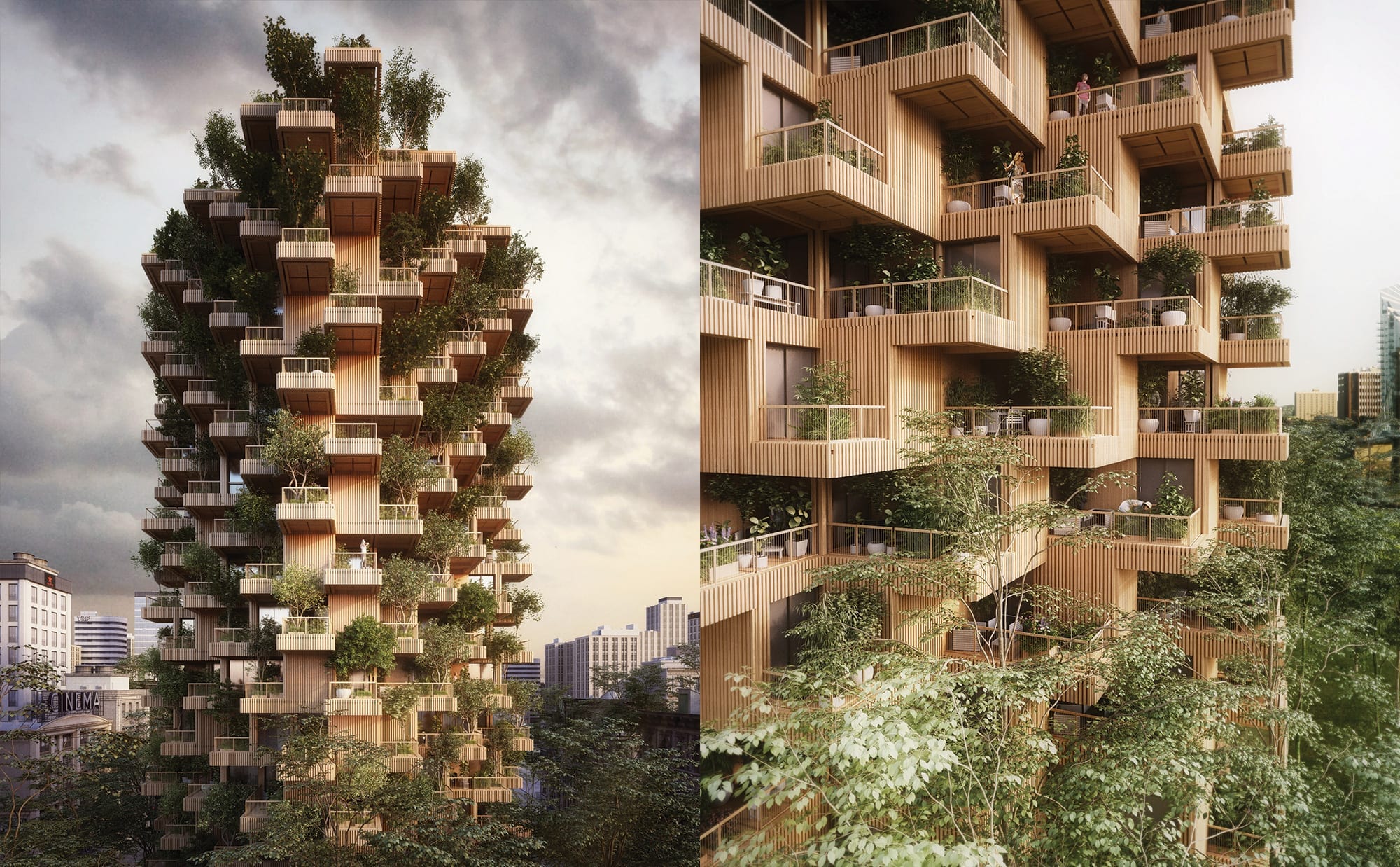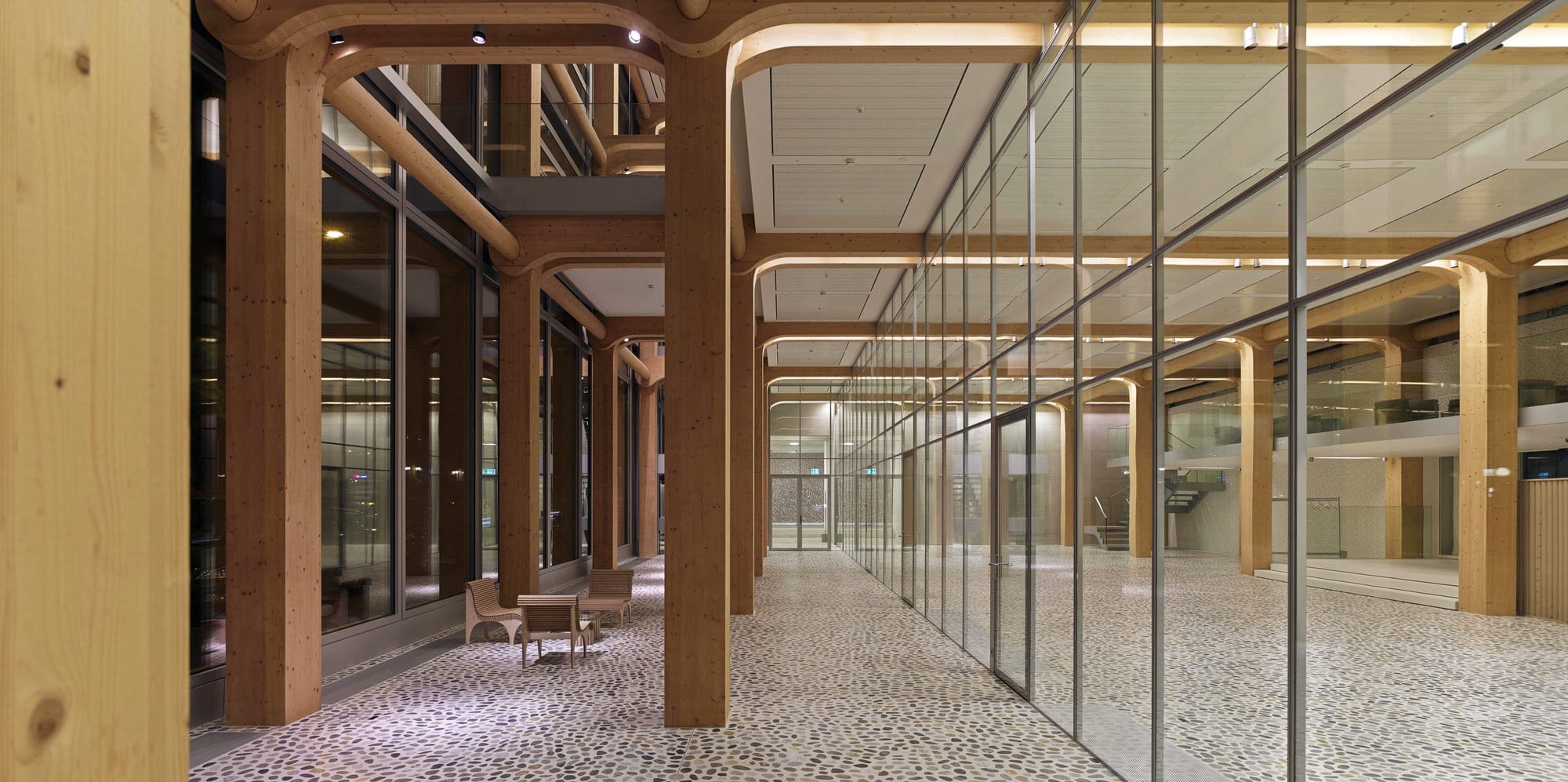With forecasts predicting that 75% of the world’s population will be living in urban areas by 2050, it is paramount that cities become more sustainable – this means using more sustainably-sourced wood building products.
The building sector contributes to 42% of final energy consumption, 35% of total GHG emissions, 50% of extracted materials, and 30% of water consumption in the European Union. Construction and housing therefore play a fundamental role when enhancing societal goals for sustainable growth and citizen wellbeing.
Today, more than ever, we must find ways to reduce the pressure on our planet’s environment and our resources: wood has a key role in making cities more sustainable. The construction sector is very resource intensive and contributes to a large share of greenhouse gas emissions. Increasing the use of renewable materials, mainly wood, in buildings, would increase the bioeconomy.
The Carbon Footprint of Products
The quantity of CO2 and other greenhouse gases (GHGs) released per unit of product during a product’s manufacturing and, in some cases, end use and disposal, is referred to as its ‘‘carbon footprint’’. Increases in GHGs in the atmosphere are considered the primary factor in global warming.
Wood has played an important role in the history of civilization. Humans have used it for fuel, building materials, furniture, paper, tools, weapons, and more. Wood is undeniably one of the oldest building materials, with evidence showing homes built over 10,000 years ago using timber. Europe’s Neolithic long house (built in 6,000 BC) is certainly an example.

According to some studies, the environmental impacts from construction are related to the renewability and recyclability of the materials used that can help mitigate climate change. The use of wood products can act as a greener alternative to more fossil-fuel intensive materials: substituting a cubic metre of wood for other construction materials (concrete, blocks or bricks) results in the significant average of saving 0.75-to-1 ton of CO2.
Wood is an excellent choice for green construction designs, which minimize the use of energy, water and materials, and reduce the subsequent impacts on human health and the environment. Wood is a high-performance and versatile choice for new construction or renovation; it is remarkably strong in relation to its weight and provides good insulation from the cold.
FAST FACTS ABOUT BUILDING WITH WOOD:
Wood products contribute to achieve the commitment undertaken by Member States and the European Union to decrease greenhouse gas emissions and enhance removals in line with the Paris Agreement. Sawmill products can play a significant role in decarbonizing the economy if governments seize the opportunity to use wood products in construction and as every day materials. The quantity of CO2 and other greenhouse gases released per unit of product during a product’s manufacturing and, in some cases, end use and disposal, is referred to as its ‘‘carbon footprint’’. Increases in GHGs in the atmosphere are considered the primary factor in global warming. Wood products have many environmental advantages compared to non-wood alternatives: indeed the manufacture of wood products requires less fossil fuel than alternative building materials. Several scientific studies had proven notable carbon emissions savings when wood products are used in constructing buildings in place of non-wood alternatives.
Wood’s natural thermal efficiency means timber systems can be more cost-effective in constructing energy-efficient buildings than cement blocks, bricks or alternative materials. Wood is especially favoured in cold climates, where, as an insulating material, it helps reduce heating costs while providing comfortable living conditions. The energy performance of buildings is key to achieving the European energy efficiency and climate objectives, in this respect wood’s thermal insulation makes it the material of choice in both cold and warm climates.
Life-cycle assessment studies that compare the environmental impacts of products show that wood building products have a lighter environmental footprint than alternative materials and offer clear environmental advantages at every stage. The manufacture of wood products requires less fossil fuel than non-wood alternative building materials, such as concrete, metals, or plastics.
As a light-weighted material that can be processed easily, wood is the ideal material for renovation and refurbishment, allowing high flexibility for inhabitants and users to adjust buildings to specific needs. Wood buildings are about a quarter of the weight of an equivalent reinforced-concrete structure, which means foundations can be smaller. Timber is a sustainable material and a natural “carbon sink” as trees lock in carbon from the atmosphere. Tall steel-and-concrete buildings tend to have a large carbon footprint, in part because of the amount of material required to support them. Using wood could reduce their carbon footprint by 60-75%.
In southern France, the city of Bordeaux has pledged to build 270,000 square feet of wooden spaces per year for the next 15 years. One of the projects leading the way is the Hypérion Tower – an 18-story residential building with CLT floors and walls that will be one of the tallest timber structures in the world when completed in 2020.
Bordeaux has pledged to build 270,000 square feet of wooden spaces per year for the next 15 years.
Each floor will have around half a dozen apartment units with private balconies and access to a shared garden. Construction is expected to take less than a year, compared to a year and a half for a version made entirely in concrete.
The Hypérion project has an additional goal: to promote the use of locally-sourced wood from the Nouvelle-Aquitaine Region that surrounds Bordeaux. The Hypérion Tower will be a showcase for chestnut and oak from the Périgord, to the north of Bordeaux, which will make up the building’s facade and beams, while the panels that secure the facades are made from pine from the nearby Landes Forest thus relying on nearby natural resources and enhancing the regional bioeconomy.

Making Sustainable Building Products
The European sawmill industry is the leading wood processing industry: this industry is on the one hand very traditional and rural – retaining a focus on products which have been used for centuries such as sawn boards and timber frames – and on the other hand it is willing to explore modern and alternative solutions, such as engineered wood products (EWPs).
While overall the production and consumption of sawn wood has been doing relatively well over the last few years, many sawmills see a bright future in the increasingly high sales of EWPs: products such as cross laminated timber (CLT) and glue laminated timber (glulam) have grown massively, and their innovative characteristics have a huge potential in helping tackle the climate change challenges that Europe will be confronted with in the future. For example, CLT buildings have the flexibility to handle the world’s strongest earthquakes with no loss of life or structural damage. They have excellent acoustic performance and are very efficient at insulation. Finally, CLT has comparatively low carbon emissions over the life-cycle of buildings and is seen, therefore, as a strong step towards providing greater sustainability.
Engineered wood products, such as cross-laminated timber (CLT), glued-laminated timber (Glulam), and structural composite lumber (SCL) that includes laminated veneer lumber (LVL), laminated strand lumber (LSL) and parallel strand lumber (PSL), all provide consistent quality and strength, changing the way buildings perform structurally and providing a predictable level of fire resistance.
The core business of the sawmill industry remains the production of sawn wood which is increasingly connected to the development of demand in more distant markets in Asia for instance. Conversely, many sawmills are proud to serve the local European markets in rural areas with trade relationships going back many decades, and in some cases, centuries.
Skyscrapers Made of Wood: the Future is Now
Although steel and concrete skyscrapers typically fill modern city skylines, architects and engineers are now considering the benefits of using wood as a material for tall buildings. Timber is both light and strong, which means it’s well suited for tall towers that must hold their own weight. At the same time, it’s not as stiff as steel and concrete, which limits the distance it can span while retaining its strength.
Today, wood is lauded for its smaller environmental footprint and the speed with which buildings can be assembled. New types of engineered timber are considerably stronger and allow architects to build bigger and higher, making timber skyscrapers a reality. Wood construction has been propulsed by using cross-laminated timber (CLT) – a strong and light-weight glued wood panel that can be made as large as desired and cut with sub-millimetre precision at the factory, which speeds up construction and reduces waste.
Wooden skyscrapers are being built now across the globe, from Norway to New Zealand, from Canada to Austria.
Local territory and global markets, tradition and innovation, rural locations and state-of-the-art facilities: the European sawmill industry has its feet planted firmly on the ground, while looking far into the future in which – thanks to the products it manufactures – it will have played an ever more relevant role in the decarbonisation of Europe.
Wood from Sustainably-Managed Forests
Sustainable wood comes from sustainably-managed forests and is defined as renewable because the forest stewards manage the landscape to prevent damage to eco-systems, watersheds, wildlife and the trees. EU Member States have introduced legal measures requiring reforestation and the protection of woodlands and forests. Today, more trees are planted than felled: European forests are growing. Sustainable forest management offers the opportunity to mitigate climate change and to contribute to sustainable development.